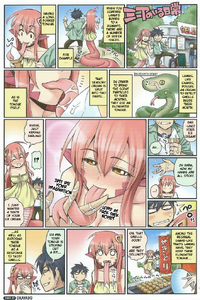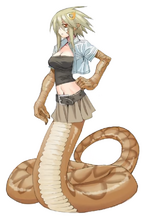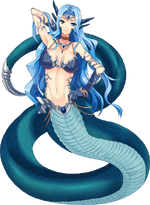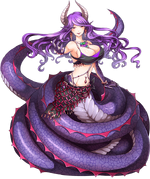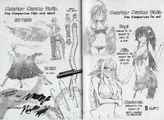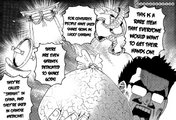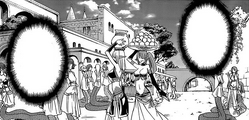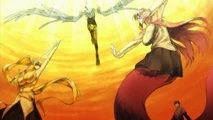No edit summary |
|||
| Line 102: | Line 102: | ||
File:Lamia13.png |
File:Lamia13.png |
||
File:Lamia14.png |
File:Lamia14.png |
||
| + | EchidnaMedusaMelusine.png |
||
File:Samplefe553223dc6f1c3be8ba001e706fef3a.jpg |
File:Samplefe553223dc6f1c3be8ba001e706fef3a.jpg |
||
File:1438202445563.jpg |
File:1438202445563.jpg |
||
Revision as of 02:38, 28 November 2018
The Lamia (ラミア族 Ramia-zoku?) are a reptilian liminal race with the upper body of a human and the lower body of a snake. A mono-gendered (female) demi-human race, Lamias are predatory carnivores that form tribal villages on the outskirts of desert oases, their serpentine tails are powerful enough to rend steel.
Culture

Lamia and subspecies.
Lamia are an extremly amorous and sexually deviant race. Believed to be deadly towards humans, Lamia are reputed to lure men back to their lairs and kill them after they've had their way with them. However, this is only partially true, as due to being a female-only race, Lamias would lure human men to their villages and hold them as 'Communal Husbands'. If the male is resistant, Lamia will use alchemical compounds such as incense to draw out their lust and force themselves upon them. Usually all the eligible members of the village would get involved, resulting in public mass orgies in the village streets as the lamia mate with the man and each other. Following the initial orgy, the male has a choice to voluntarily stay or leave. According to Miia's mother the men usually choose to stay, due to the beauty and sexual skills of the lamias.
Since the Cultural Exchange Between Species Bill, government agencies have put a stop to the Lamia practice of kidnapping and keeping 'communal husbands' against their will. In an attempt to compensate for this, Lamia villages have taken to sending "representatives" via the exchange program for the purpose of acquiring a communal husband for the village.
According to Miia's mother, lamia are very skilled poison users and chemists which she backs when she reveals the tea she brought had been spiked with weak neurotoxin. She later used a special incense that acted as an aphrodisiac, though it proved ineffective.
Physiological Attributes
- Lamia are Poikilotherms, organisms that do not have a stable internal temperature and must rely on external sources to maintain a healthy body temperature. As such, they are extremely vulnerable to cold temperatures and will either fall into hibernation and/or die if left exposed to low temperatures for too long.
- The tip of a lamia's tail is an extremely sensitive erogenous zone.
- Lamias posses a sensory organ similar to pitvipers that allows them to see heat signatures. With it, they can follow the heat signature of their prey even in the dark.
- As carnivores, lamia have twenty times less the number of taste buds as omnivores (e.g. humans), while omnivores generally have half as many taste buds as herbivores (e.g. Centaurs).
- Lamia will shed their skin once in awhile, just like regular snakes. Interestingly, Lamias find being seen skin shedding to be more embarrassing than being seen naked, much like most snakes finding some place private to shed, and will lash out if someone attempts to handle them, though that's mainly because when snake shed, their eyesight becomes temporarily compromised.
- Lamias have a special food preference for eggs, which can be in reference to snakes that evolved an egg-specific diet.
- Given that they are part snake, Lamia can also go without food for several days.
- As an evolutionary fall-back to their snake-origins, a Lamia's tongue is very long in length and has a naturally "forked" tip. Like a snake, the tip of a Lamia's tongue possesses the Jacobson's organ, a sensory organ that allows a Lamia to detect smells in the air.
- This tongue is also prehensile to a degree, just like a human's; and like snakes, lamia may stick out their tongues as a result of delicious smells in the air.
- Possibly due to the lack of a male equivalent of their species but the biological need of one, Lamia are openly erogenous from a young age. Some sexual subjects and diviancies that are considered taboo in some human cultures (such as public sex, polygamy and underage sex) are considered acceptable, encouraged and actively practised in Lamia culture.
- It is shown in Chapter 60 that Lamia will even engage in sexual activity with other women, even fellow Lamia (assuming that they are not closely related), showing that they are bisexual, much like Satyrs.
Subspecies
Echidna
Echidnas (エキドナ, Ekidona) are a subspecies of Lamia. Because more of their bodies are covered by scales compared to lamias, echidnas are more closely related to Lizardfolk. Their name means "viper women", and true to their name, they possess poisonous fangs inside their mouths. Their venom is a type of hemorrhagin (meaning that it breaks down blood vessels) and must be treated with caution. Their snake-like lower bodies are covered in a unique pattern reminiscent of vipers.
Medusa
Medusae (メデューサ, Medyūsa) are a subspecies of Lamia with snakes for hair. Also known as Gorgons (ゴーゴン, Gōgon), in mythology, their gaze are said to turn creatures into stone, but in reality they possess no such ability. However, their gaze does seem to be very keen, and their glare makes living creatures unable to move, as though they indeed have been turned to stone.
This is due to the fact that they have poor eyesight. They only appear to be glaring as they are only trying to see more clearly. Because their hair is made of snakes they are tragically troubled by the fact that they can't change their hairstyle.
Melusine
Melusines (メリュジーヌ, Meryujīnu) are a lamia subspecies with dragon wings on their backs. Due to this, they share characteristics with Dragonewts. In contrast to other lamia subspecies, they are more similar to sea snakes than terrestrial snakes and prefer to live by the shore. Sadly, their wings aren't strong enough to lift their long lower bodies, making said wings being more vestigial in nature.
Ena, Gina and Lucine are Melusine
Sea Serpent
The Sea Serpent is a reptilian liminal race with the upper body of a human and the lower body of a sea snake.
A subspecies of the Lamia, Sea Serpents were a type of "Sea Monster" that first appeared in ancient Norse mythology, but have since appeared in one form or another in the myths of virtually every existing culture that has had interactions with the sea. This is due to the fact that, while an aquatic species, Sea Serpents are air breathers and do not possesses gills like Mermaids. As a result they must surface regularly to breathe which has resulted them being sighted by numerous seafaring vessels throughout the centuries.
Sea is a Sea Serpent
Jormungand
The Jormungand (or Midgardsormr) is an aquatic Lamia subspecies that appears prominently in Norse-Germanic Mythology.
Said to be born from the giantess Angrboda and the trickser god Loki. The god Odin took Loki's three children (Fenrir, Hel, and Jormungandr) and tossed Jormungandr into the great ocean that encircled Midgard. In the depths, Jormungandr grew to gargantuan size and became embroiled in a rivalry with the god Thor. On Ragnarok (the final battle at the end of the world), Thor and Jormungandr are destined to kill each other.
Iormu is a Jormungand
Members
- Miia (Lamia)
- Miia's Mother (Lamia)
- Miia's Lamia Sisters (Lamia)
- Sea (Sea Serpent)
- Ena (Melusine)
- Iormu (Jormungand)
- Media (Medusa)
- Gina (Melusine)
- Shiana (Medusa)
- Lucine (Melusine)
Gallery
Trivia
- The Lamia race consists of only females, thus in order to breed, they must mate with human men.
- Lamia mating can take around 6-10 hours on average. Due to this, a Lamia's partner seldom has the stamina to keep up with them. If a man lingers or hesitates once sexual intercourse is finished, he is considered engaged to that Lamia.
- The first of The Eight Brothers is dating a Lamia.
- The Lamia, much like the Arachne, are inspired by Greek mythology via a godly-cursed individual. Lamia was the queen of Libya who was also a mistress of Zeus. This automatically earned her the ire of Hera, Zeus' wife, who killed Lamia's children and then transformed her into a child-eating demon. Her name is supposedly derived from the Greek word for "gullet" (λαιμός, laimos), which is a reference to her habit of eating children. The depiction of Lamia with a snake's tail is from a 1819 poem by English poet John Keats and has since become the common depiction of Lamia in other forms of media, though the imagery often clashes with the Gorgons, hence why they (Gorgon) are considered in Monster Musume as a lamia subspecies.
- It's revealed in Chapter 27 that Lamia tribes used to kidnap and trick human men into becoming communal husbands for the entire tribe. Miia was entered into the Exchange Program in order to find a husband for her tribe, until she fell for Kurusu and wanted him for herself.
- It's also revealed that other tribes have sent their daughters for the same reason.
- Their original tradition likens Lamia to Common garter snakes, although it's more of the opposite. While some male garter snakes lure other males away from the females so that they can mate with as many females he can, Lamia on the other hand, lure human men into their homes so that the entire tribe can mate with him and maintain their numbers.
- This implies that Lamia tribes are made up of just one or two biological families, consisting of mothers, daughters, half-sisters and likely aunts as well.
- A Lamia's undergarments consist of a silicon decorative triangle that they place over their genitals to serve in the aspect as panties.
- Some can interpret a nightmare Miia had as evidence lamias sometimes kill their men through exhaustion during sex. However, no actual mention of this is ever made (even in the nightmare Kimihito was not killed, just drained comedically, and this was just a dream). For instance the lamia tribes were threatened with charges of kidnapping, not murder.
- They are about 7m long, between Yurlunggur and Gigantophis in length.


